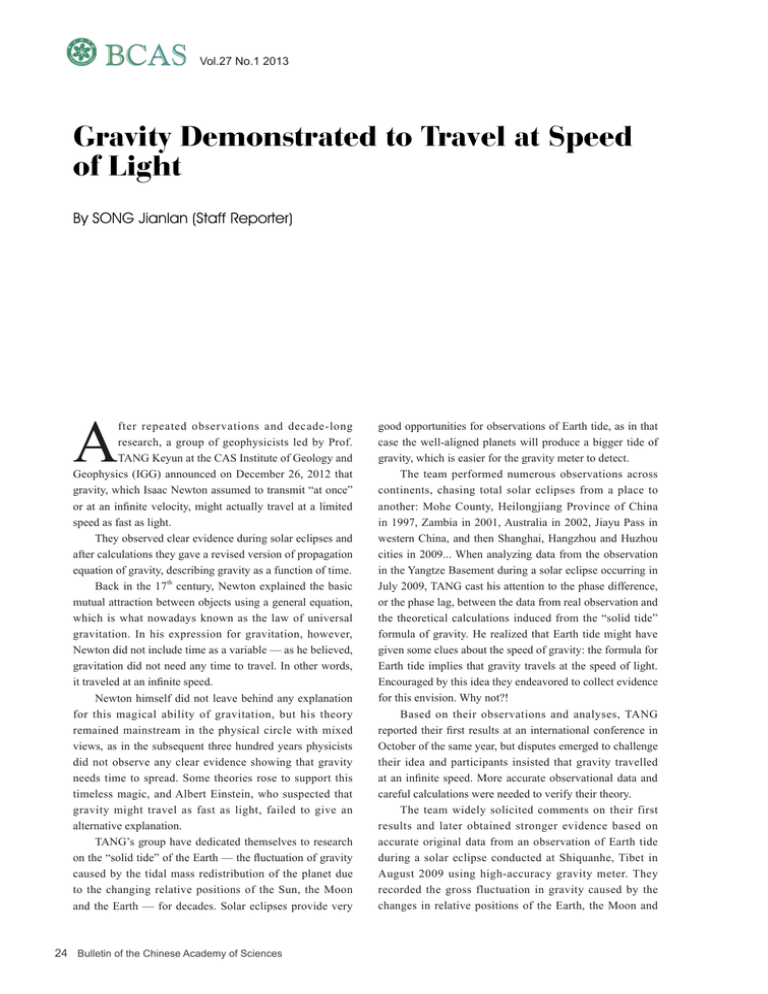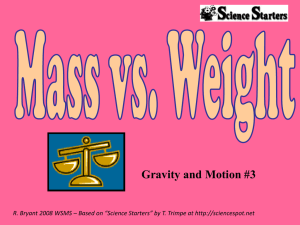Gravity Demonstrated to Travel at Speed of Light
advertisement

BCAS Vol.27 No.1 2013 Gravity Demonstrated to Travel at Speed of Light By SONG Jianlan (Staff Reporter) A fter repeated observations and decade-long research, a group of geophysicists led by Prof. TANG Keyun at the CAS Institute of Geology and Geophysics (IGG) announced on December 26, 2012 that gravity, which Isaac Newton assumed to transmit “at once” or at an infinite velocity, might actually travel at a limited speed as fast as light. They observed clear evidence during solar eclipses and after calculations they gave a revised version of propagation equation of gravity, describing gravity as a function of time. Back in the 17th century, Newton explained the basic mutual attraction between objects using a general equation, which is what nowadays known as the law of universal gravitation. In his expression for gravitation, however, Newton did not include time as a variable — as he believed, gravitation did not need any time to travel. In other words, it traveled at an infinite speed. Newton himself did not leave behind any explanation for this magical ability of gravitation, but his theory remained mainstream in the physical circle with mixed views, as in the subsequent three hundred years physicists did not observe any clear evidence showing that gravity needs time to spread. Some theories rose to support this timeless magic, and Albert Einstein, who suspected that gravity might travel as fast as light, failed to give an alternative explanation. TANG’s group have dedicated themselves to research on the “solid tide” of the Earth — the fluctuation of gravity caused by the tidal mass redistribution of the planet due to the changing relative positions of the Sun, the Moon and the Earth — for decades. Solar eclipses provide very 24 Bulletin of the Chinese Academy of Sciences good opportunities for observations of Earth tide, as in that case the well-aligned planets will produce a bigger tide of gravity, which is easier for the gravity meter to detect. The team performed numerous observations across continents, chasing total solar eclipses from a place to another: Mohe County, Heilongjiang Province of China in 1997, Zambia in 2001, Australia in 2002, Jiayu Pass in western China, and then Shanghai, Hangzhou and Huzhou cities in 2009... When analyzing data from the observation in the Yangtze Basement during a solar eclipse occurring in July 2009, TANG cast his attention to the phase difference, or the phase lag, between the data from real observation and the theoretical calculations induced from the “solid tide” formula of gravity. He realized that Earth tide might have given some clues about the speed of gravity: the formula for Earth tide implies that gravity travels at the speed of light. Encouraged by this idea they endeavored to collect evidence for this envision. Why not?! Based on their observations and analyses, TANG reported their first results at an international conference in October of the same year, but disputes emerged to challenge their idea and participants insisted that gravity travelled at an infinite speed. More accurate observational data and careful calculations were needed to verify their theory. The team widely solicited comments on their first results and later obtained stronger evidence based on accurate original data from an observation of Earth tide during a solar eclipse conducted at Shiquanhe, Tibet in August 2009 using high-accuracy gravity meter. They recorded the gross fluctuation in gravity caused by the changes in relative positions of the Earth, the Moon and Vol.27 No.1 2013 150 100 Gravity (10-8 m/s2) C 50 0 B A Partial view Observational data from Shiquanhe Station, Aug 21, 2009: -50 -100 C -- Theoretical true position; B -- Theoretical apparent position; A -- Observed position -150 0 20000 40000 60000 80000 100000 Time (s) Accurate observational data of Earth tide during a total solar eclipse obtained at Shiquanhe, Tibet suggests that gravity might travel at a limited speed as fast as light, rather than at an infinite speed. C B A Gravity (10-8 m/s2) 5.8 131.7s 4.6 38.5s Observational data from Shiquanhe Station, Aug 21, 2009: C -- Theoretical true position; B -- Theoretical apparent position; A -- Observed position. 4.0 19800 20100 20400 Time (s) Detail of the comparison between the observed curve and the theoretical calculations: The phase lag of the observed values of gravity compared with the theoretical ones denied the possibility that gravity could spread in “no time”. the Sun, and extracted from it the part of tide produced by the changes in relative positions of the Sun and the Earth. After a comparison with the calculations from the Earth tide formula, they got the phase lag between the observed values and theoretical ones of gravity — the noticeable delay clearly denied the “infinite” speed of gravity. After correction of phase lag due to the anelasticity of the Earth, the team obtained the speed of gravity, which is determined to be about 0.93 to 1.05 times the speed of Science Highlights light, with a relative error of about ±5%. Starting from there they revised Newton’s formula of universal attraction and published their theory in the Chinese Science Bulletin with open access on the website of Springerlink.com at the end of the year 2012. So far, applications of the revised version of gravity have led to encouraging news: Astronomical calculations derived from the new formula, including the perihelion precession in the orbit of the planet Mercury, fitted better with the observations and equaled to the outcome from Einstein’s general relativity theory. Their result, however, again stirred a big wave of controversy. Some scholars questioned the methodology, believing it could be a circular argument or has adopted a wrong frame of reference, but the team insisted the validity of their observation and analysis. Some others challenged that mass redistribution of the Earth could be heterogeneous and unpredictable due to its unclear mechanism and the complicated composition of the planet. From their view Earth tide might not be in isochronous response to the changes in the relative positions of the Earth and the Sun, hence there could be a delay. The team answered that the anelasticity lag in Earth tide could have some influence, but this influence is limited. According to long-term research of this phenomenon, this lag is about one order smaller compared with the one produced by the delay resulting from gravity’s travelling from the Sun to the Earth. “This error cannot change the conclusion that gravity travels at the speed of light,” commented CHI Shunliang, coauthor of the paper: “and we have weeded out this part of error in our calculation based on experience from past observations.” “Actually we came to the initial conclusion as early as May 2010. We did not publish our results in any peer-review journal, however, because we were aware that it was really a big deal and caution was important. We thought that more extensive suggestions and ideas were needed,” CHI continued, emphasizing that their results are still open to tests. Disputes are still on the rise when this report is finished. Whether or not gravity travels at the speed of light, scientific exploration is in a timeless universe where no terminal can be defined. Bulletin of the Chinese Academy of Sciences 25

